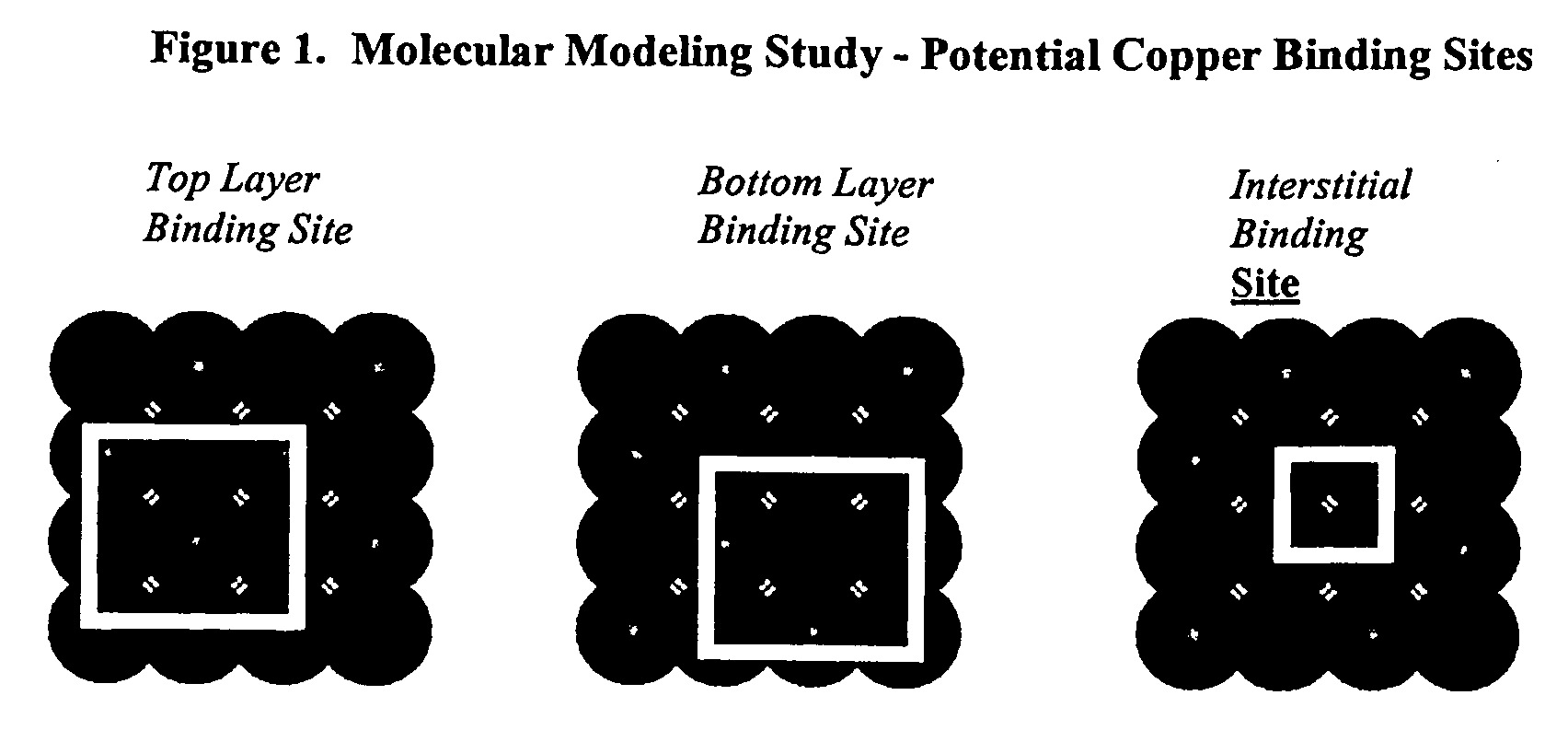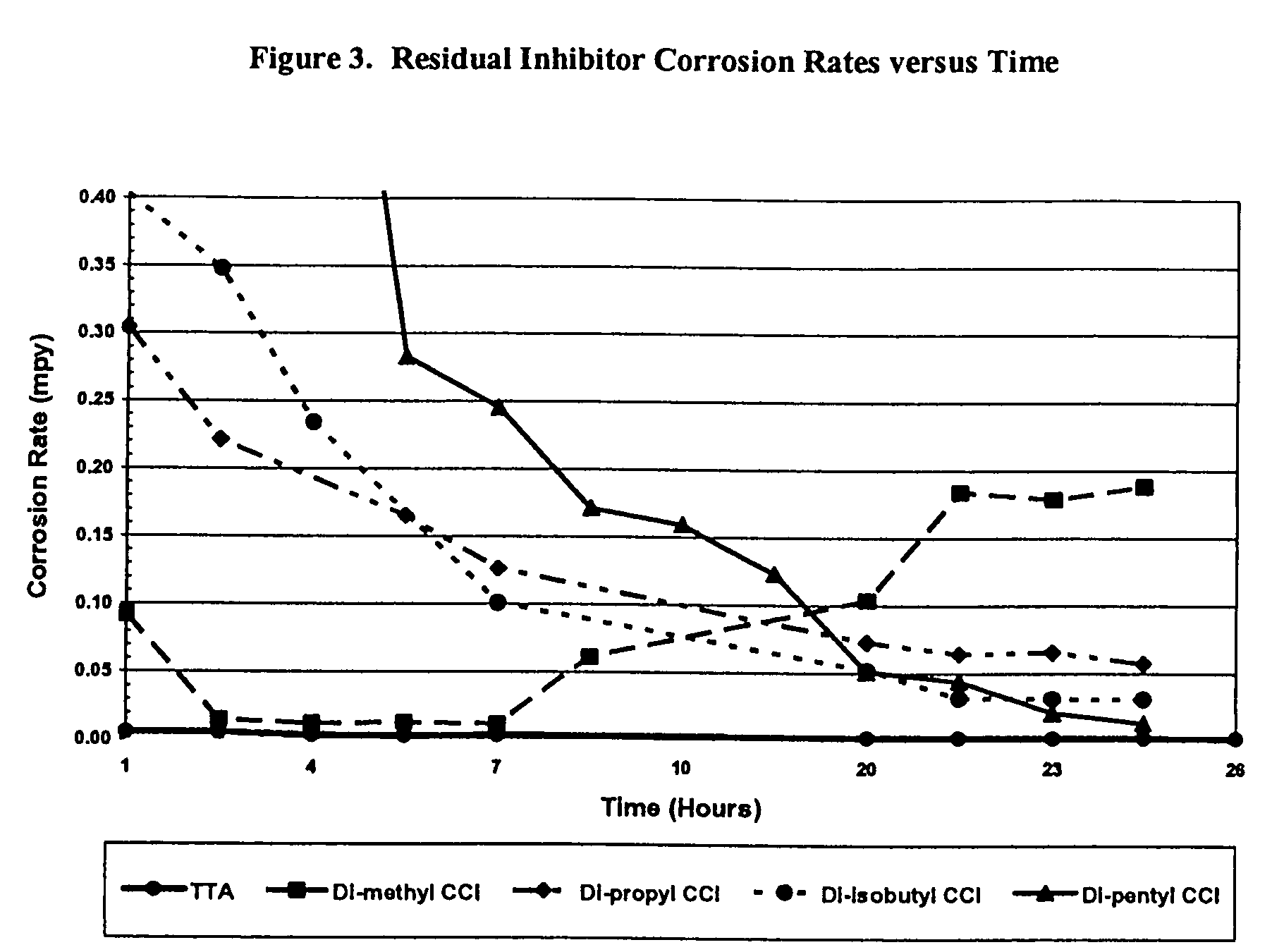Sulfur based corrosion inhibitors
a corrosion inhibitor and sulfur based technology, applied in the field of corrosion inhibitors, can solve the problems of accelerated corrosion rate, triazole dominance, tta dominance, etc., and achieve the effects of reducing cost, preventing corrosion, and residual water level
- Summary
- Abstract
- Description
- Claims
- Application Information
AI Technical Summary
Benefits of technology
Problems solved by technology
Method used
Image
Examples
example 1
Preparation of Sodium Dimethyl Dithiocarbamate as an Aqueous Solution
[0102] A clean, dry, four-neck 500 mL flask was charged with 59.6 g of city water, 39.0 g (0.52 mol) of 60% aqueous dimethyl amine, and a large stir bar. Stirring was initiated and the flask was fitted with a condenser, thermocouple, and heating mantle. A 25 mL addition funnel was charged with 38.0 g (0.50 mol) of carbon disulfide and attached to the reaction flask. A 50 mL addition funnel was charged with 40.0 g (0.50 mol) of 50% sodium hydroxide and attached to the reaction flask. The reaction was then heated to 30° C. with stirring.
[0103] When the reactor contents had reached 30° C., the carbon disulfide feed was started at a slow drop-wise rate. After five minutes the sodium hydroxide feed was also started at a slow drop-wise rate. The feeds were regulated such that the reaction temperature did not exceed 45° C., and both additions were complete after approximately one hour. The reaction was then allowed to ...
example 2
Preparation of Sodium Diethyl Dithiocarbamate as an Aqueous Solution
[0104] A clean, dry, four-neck 500 mL flask was charged with 113 g of city water, 19.0 g (0.26 mol) diethyl amine, and a large stir bar. Stirring was initiated and the flask was fitted with a condenser, thermocouple, and heating mantle. A 25 mL addition funnel was charged with 19.0 g (0.25 mol) of carbon disulfide and attached to the reaction flask. A 50 mL addition funnel was charged with 20.0 g (0.25 mol) of 50% sodium hydroxide and attached to the reaction flask. The reaction was then heated to 30° C. with stirring.
[0105] When the reactor contents had reached 30° C., the carbon disulfide feed was started at a slow drop-wise rate. After five minutes the sodium hydroxide feed was also started at a slow drop-wise rate. The feeds were regulated such that the reaction temperature did not exceed 45° C., and both additions were complete after approximately one hour. The reaction was then allowed to cook for one hour ...
example 3
Preparation of Sodium Dipropyl Dithiocarbamate as an Aqueous Solution
[0106] A clean, dry, four-neck 500 mL flask was charged with 189 g of city water, 36.9 g (0.365 mol) dipropyl amine (Aldrich, 99%), and a large stir bar. Stirring was initiated and the flask was fitted with a condenser, thermocouple, and heating mantle. A 25 mL addition funnel was charged with 26.6 g (0.35 mol) of carbon disulfide and attached to the reaction flask. A 50 mL addition funnel was charged with 28.0 g (0.35 mol) of 50% sodium hydroxide and attached to the reaction flask. The reaction was then heated to 30° C. with stirring.
[0107] When the reactor contents had reached 30° C., the carbon disulfide feed was started at a slow drop-wise rate. After five minutes the sodium hydroxide feed was also started at a slow drop-wise rate. The feeds were regulated such that the reaction temperature did not exceed 45° C., and both additions were complete after approximately one hour. The reaction was then allowed to ...
PUM
| Property | Measurement | Unit |
|---|---|---|
| corrosion rates | aaaaa | aaaaa |
| temperature | aaaaa | aaaaa |
| temperature | aaaaa | aaaaa |
Abstract
Description
Claims
Application Information
 Login to View More
Login to View More - R&D
- Intellectual Property
- Life Sciences
- Materials
- Tech Scout
- Unparalleled Data Quality
- Higher Quality Content
- 60% Fewer Hallucinations
Browse by: Latest US Patents, China's latest patents, Technical Efficacy Thesaurus, Application Domain, Technology Topic, Popular Technical Reports.
© 2025 PatSnap. All rights reserved.Legal|Privacy policy|Modern Slavery Act Transparency Statement|Sitemap|About US| Contact US: help@patsnap.com



